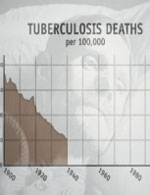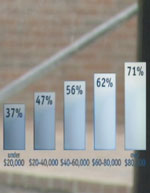
EXPLORE BY TOPIC:
  Our top 10 resources
Our top 10 resources
  Childhood / Early Life
Childhood / Early Life
  Chronic Stress
Chronic Stress
  Education
Education
  Food Security
Food Security
  Genetics
Genetics
  Jobs & Work
Jobs & Work
  Housing / Neighborhoods
Housing / Neighborhoods
  Income & Wealth
Income & Wealth
  Race / Racism
Race / Racism
  Social Inclusion
Social Inclusion
  Policy & Change
Policy & Change





Buy or Stream
e-Newsletter
Frequently Asked Questions
Contact Us
Site Map

|
 |
 Amazing Facts

Download as a pdf »
Dollars and Sense
- U.S. businesses lose more than $1 trillion a year in productivity due to chronic illness.
- Per person, the U.S. spends more than twice the average of other industrialized countries on health care - 16% of our GDP in 2006 - yet has some of the worst health outcomes: worse than 28 other countries in life expectancy (including Jordan) and 29 other countries in infant mortality (including Slovenia).
- The U.S. child poverty rate (21.9%) is five times that of Sweden (4.2%). It’s not surprising that, when it comes to social spending, the figures are reversed: Sweden allocates 18% of its GDP to social spending while the U.S. allocates only 4%.
In Sickness and In Wealth
- People in the highest income group can expect to live, on average, at least six and a half years longer than those in the lowest. Even those in the middle (families of four making $41,300 to $82,600 a year in 2007) will die, on average, two years sooner than those at the top.
- Low-income adults are 50% more likely to suffer heart disease than top earners. Those second from the top are almost 20% more likely than those at the` top.
- College graduates can expect to live at least five years longer than those who have not finished high school, and almost two years longer than those who didn’t finish college.
- Children living in poverty are about seven times as likely to be in poor or fair health than children living in high-income households. Middle class children are twice as likely to be in poor or fair health than those at the top.
- Rates of illness for U.S. adults in their 30s and 40s with low income and lower education are comparable to those of affluent adults in their 60s and 70s.
- Low-income smokers are more likely to become ill and die sooner from tobacco related diseases than smokers who are wealthy.
- The top 1% of the U.S. population holds more wealth than the bottom 90% combined. During the past 25 years, while the rich became richer, the net worth of the least affluent 40% of American families fell by half.
The U.S. and the World
- For all the rich countries for which there is data, the U.S. has:
- the highest infant mortality rate
- the highest homicide rate
- the highest teenage birth rate
- the highest incarceration rate (we house one fourth of the world’s prisoners)
- the highest child poverty rate
- the highest child injury death rate
- the greatest gap between high and low mortality rates within a country
- the highest number of people living alone
- the highest poverty rate
- the most hours worked (except for New Zealand)
- the smallest middle class
- the largest wealth gap between the rich and the rest of the population
- the lowest voter turnout
- A study published by the journal Health Affairs found that Americans were nearly twice as likely as Europeans to be obese (33.1% versus 17.1%).
- The Japanese smoke twice as much as Americans but still live four years longer, on average, than we do.
- Many African American and Native American populations are less likely to reach 65 than people from Bangladesh or Ghana. African American males living in Washington, D.C. have a lower life expectancy (57.9 years) than men in Bangladesh (58.1) and Ghana (58.3).
- The Pima Indians of southern Arizona suffer one of the highest diabetes rates in the world. One study found that 40% of Pima adults are afflicted, while, across the border, fewer than 7% of the Mexican Pima had diabetes.
- The U.S. is the only industrialized nation that doesn’t require employers to provide paid sick leave. When they get sick, 47% of U.S. private sector workers must choose between staying home or losing a day’s pay.
- The U.S. is the only industrialized country that doesn’t require paid vacations by law. As a result, one in four American workers receive NO paid holidays or vacations. European countries mandate paid holidays and vacations of between four and six weeks.
Health Gaps in Black, White, Red and Brown
- Racial and ethnic health inequities don’t just reflect income. More African American, Native American, Latino and Pacific Islanders are in poor or fair health than whites at practically every income level (although recent Latino immigrants report better health).
- In California, 90% of students in overcrowded schools are children of color, two thirds of them Latino.
- Former U.S. Surgeon General Dr. David Satcher and colleagues calculated that in 2002, 83,570 African Americans died who would not have if Black and white mortality rates were equal. That’s 229 “excess deaths” per day: the equivalent of an airplane loaded with Black passengers being shot out of the sky and killing everyone on board every single day of the year.
- 33% of African American children, 29% of Native American children, and 28% of Latino children live below the poverty line ($20,650 for a family of four in 2007), compared to 9.5% of white children.
- The prevalence of HIV infection among Blacks doubled in the last decade while remaining stable among whites.
- On average, there are four times as many supermarkets in predominantly white neighborhoods as there are in predominantly Black or Latino neighborhoods.
- Racial segregation in many major American cities, including New York, Chicago, Milwaukee and Detroit, approaches that of South Africa under apartheid.
- African American women—of any class—who reported high levels of experience with racial discrimination were nearly five times as likely to deliver underweight babies as those who reported no experience with it.
- Although typically poorer, recent Latino immigrants are healthier than the average American. However, those who have lived in the U.S. five years or longer are 50% more likely to have high blood pressure and almost 40% more likely to be obese.
- Among employed Californians, Latinos are 11 times as likely as whites to live in poverty.
|











